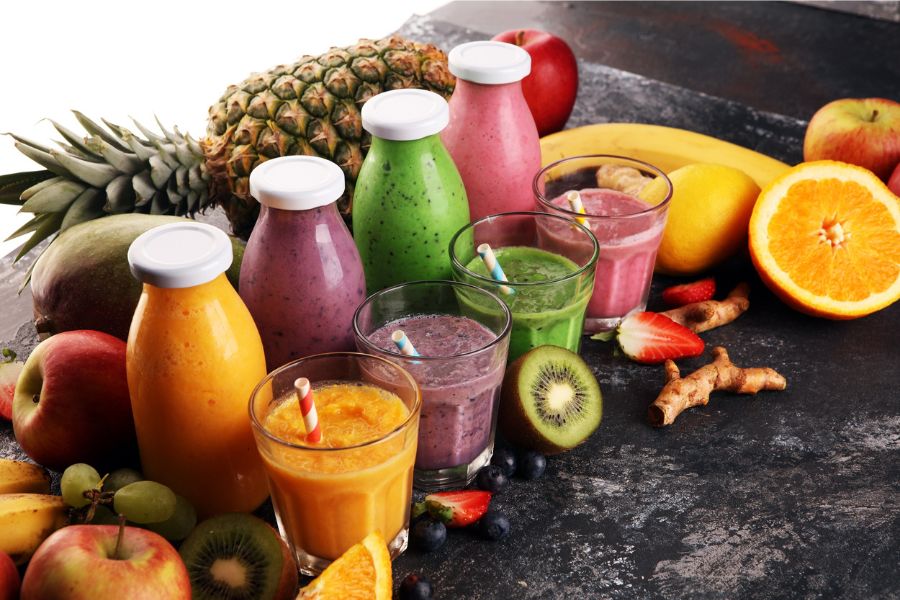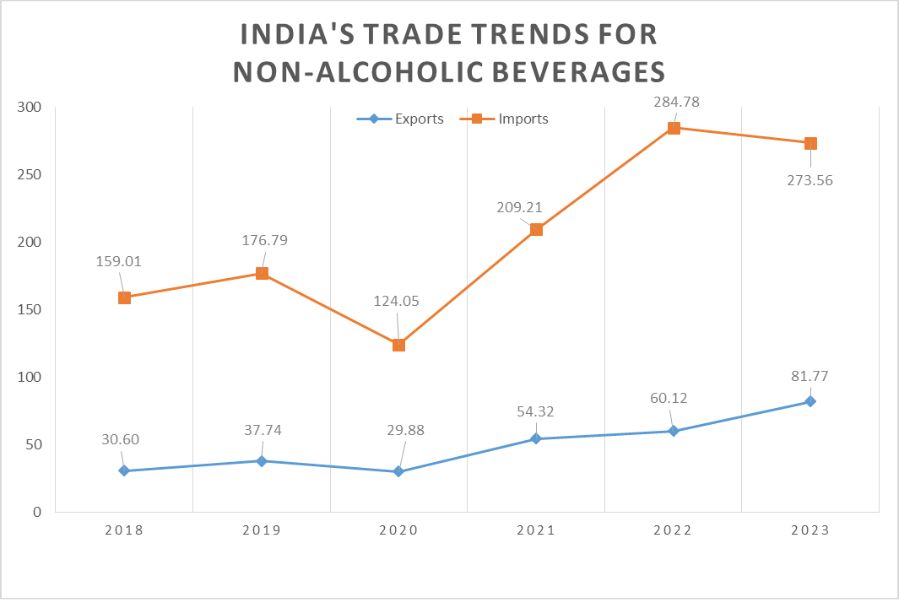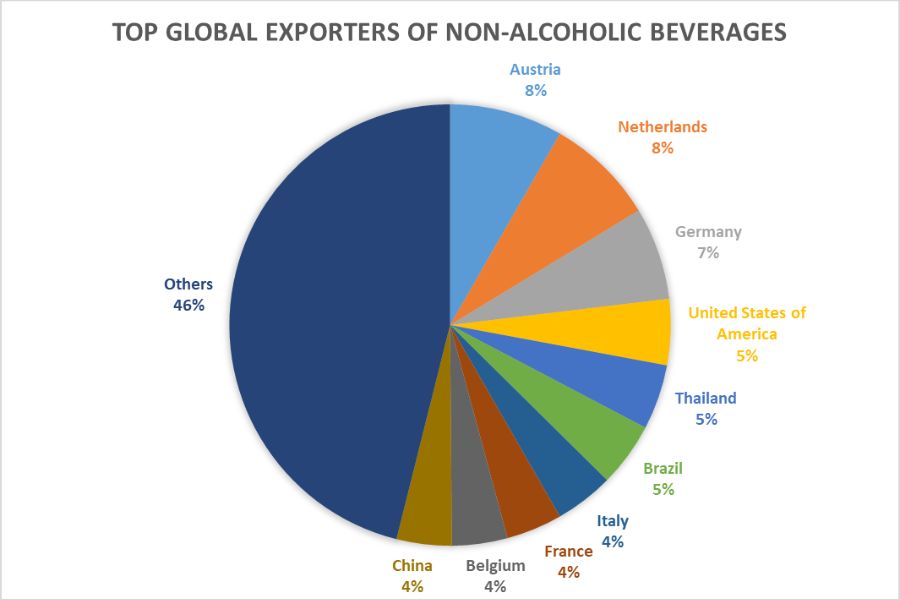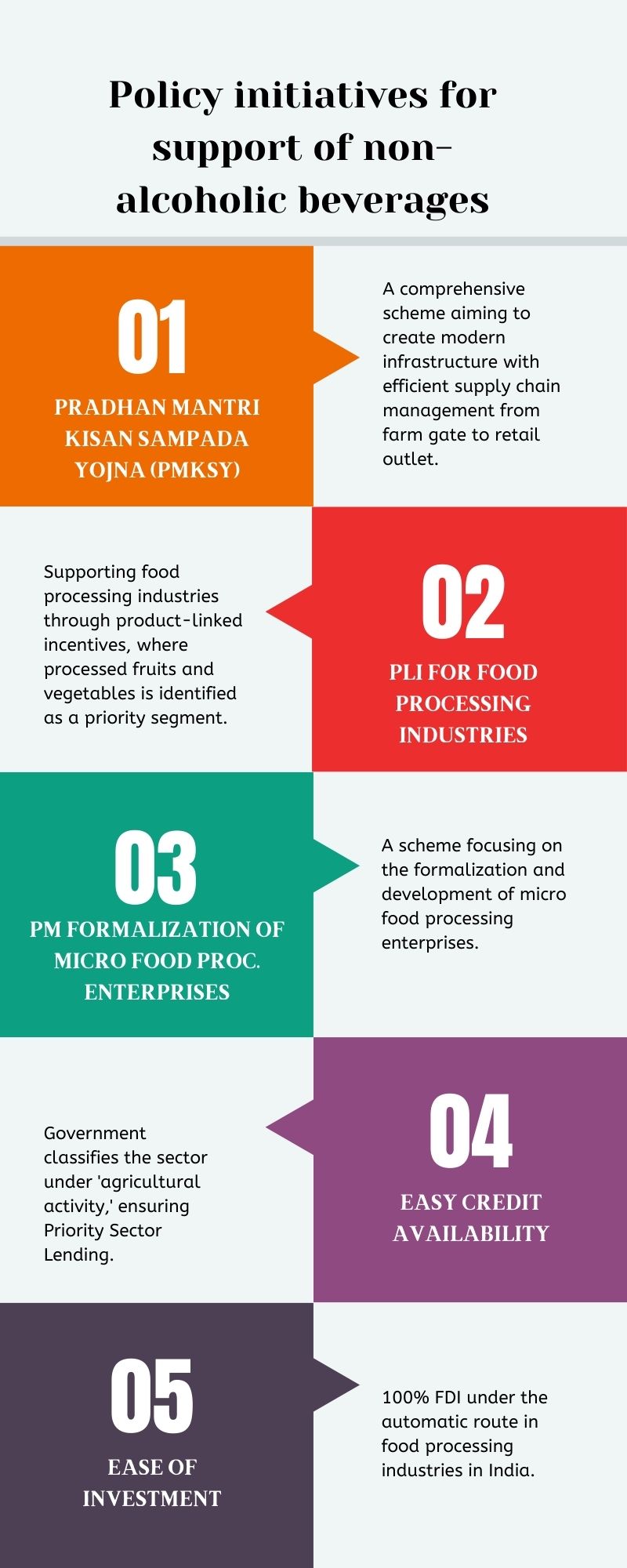Non-alcoholic beverages: Spirited pursuit of a $50 bn global opportunity
India’s non-alcoholic beverage industry is flourishing, propelled by a youthful, and increasingly prosperous demographic and backed by the availability of ample raw materials. The domestic market is poised to reach a size of US$ 21.5 billion by 2028, growing at a CAGR of 6.72% over the next 4 years. Increasing health consciousness and growing disposable incomes are steering demand towards a varied range of healthier alternatives.
However, India’s share in global trade is extremely low, with a global rank of 57 in a market led by Austria, Germany and the US. The industry faces various challenges including elevated taxes, infrastructure constraints and mismatch of the taxation regime with global demand trends. This article dives deep into these issues and future prospects.

Image Credit: Shutterstock
The non-alcoholic beverage market is experiencing rapid expansion across the globe, as well as the rise of newer players and innovative products. Companies in this sector are offering a wide array of products ranging from carbonated soft drinks to juice-based drinks, sports drinks, organic drinks, pulp-based drinks, and even wine. The global non-alcoholic beverage market is forecasted to maintain a steady growth trajectory with a CAGR of 7.3% to reach US$ 2.2 trillion in 2026. This presents a significant opportunity for India to capitalize on the rising global demand for non-alcoholic beverages by leveraging its abundant resources of raw materials.
Global imports of non-alcoholic beverages reached a size of US$ 48.5 billion in 2022, growing at a 5-year CAGR of around 5%. The top markets in terms of share were the US (17%), Germany (7%), UK (7%), Netherlands (5%) and France (4%). In terms of 5-year CAGR, the fastest growing markets (among the top 20) were Turkey (38%), Austria (14%), China & Poland (13%) and the UK (7%).
With a population skewed towards younger consumers, particularly those aged between 18 and 40, the market presents a significant opportunity for manufacturers to introduce a diverse range of products. The industry caters not only to basic hydration needs but also plays a crucial role in maintaining the body’s pH balance, offering nourishment to invalids, infants, and convalescents. Moreover, per capita sales volume in India (21.36 litres in
2018) is much lower than other developing countries like Philippines (111.89 litres) and Vietnam (69.75 litres).
Furthermore, these drinks serve as instant energy boosters post-exertion, making them ideal for replenishment after sports, games, or other physically demanding activities. Their practical significance extends to preventing dehydration and maintaining blood volume in various scenarios, such as bleeding, heatstroke, vomiting, excess sweating, or diarrhea. It becomes evident that the rising trend in non-alcoholic beverages aligns seamlessly with the growing demand for healthier and more mindful choices, setting the stage for a dynamic industry poised for continued expansion.
Trade Analysis
India stands out as the largest global producer of banana, mango, lime, lemon, papaya, milk, and sugar, which are key raw materials for the non-alcoholic beverages. The food and beverage industry in India is one of the fastest-growing sectors, fueled by a robust raw material production base. The domestic non-alcoholic beverage market is poised to reach a size of US$ 21.5 billion by 2028, growing at a CAGR of 6.72% over the next 4 years.
This growth is driven by several factors, including the increasing affluence of the expanding working population, a rise in disposable income, growing urbanization leading to shifting lifestyles and time constraints for home-cooked meals, a surge in tourism and international travel, and a heightened consumption of rapidly growing food and beverage segments during special occasions and celebrations.
Key Growth Drivers for the Non-Alcoholic Beverage Sector |
|
| Demographics
|
|
| Rising Health Awareness
|
|
| Increasing Disposable Incomes |
|
| Change in Consumer Preferences |
|
| Improving Infrastructure
|
|
Source: ICRIER
However, India’s position in global exports of non-alcoholic beverages is not reflective of its potential. Imports in this category were estimated at US$ 273.6 million in 2023 (5-year CAGR of 11.5%), while imports were at just US$ 81.8 million (5-year CAGR of 21.7%), leading to a trade deficit of US$ 191.8 million. For analysing the trade in this category, we have considered three 4-digit HS Codes:
HS 2201: Waters, incl. natural or artificial mineral waters and aerated waters, not containing added sugar or other sweetening matter…
HS 2202: Waters, incl. mineral waters and aerated waters, containing added sugar or other sweetening …
HS 2009: Fruit juices, incl. grape must, and vegetable juices, unfermented, not containing added spirit, …

Source: DGCIS, ITC Trade Map, figures in US$ million;
India’s exports and imports are dominated by one category – HS 2202. Exports for this category reached US$ 60.3 million in 2023 and imports were recorded at US$ 240 million. Even globally, this is the highest contributor to trade in non-alcoholic beverages with imports of US$ 26.9 billion in 2022, followed by HS 2009 (US$ 17 billion) and HS 2201 (US$ 4.5 billion).
Among global exporters, India ranks at 67, with a global market share of just 0.12%. The top position was taken by Austria in 2022 (US$ 3.9 billion), which is closely followed by Netherlands (US$ 3.8 billion). Germany (US$ 3.2 billion), US (US$ 2.3 billion) and Thailand (US$ 2.29 billion) took up ranks 3, 4 and 5 respectively. Notably we cannot say that there is a dominant player yet in this market, even though the top ten have taken 54% of the market collectively.

Source ITC Trade Map, figures for 2022
India’s exports on the other hand were dominated by UAE in 2022 (US$ 16.12 million) followed by the US (US$ 8.3 million), Nepal (US$ 7 million) and Netherlands (US$ 4.3 million). It is clear that there is a long way to go for India to make a mark in this segment internationally. However, the growth in the domestic market is a positive sign, as players are enthused to expand capacities and build strong product portfolios in this segment. This could reflect in export performance in the coming year. However, the industry also faces some critical challenges as surmised in a report by ICRIER:
High GST and Sin Tax Impact: Elevated GST rates and the imposition of additional “sin tax” based on the 2015 Subramanian Committee Report pose financial challenges for the sector.
GST Rates Misalignment with FSSAI Regulation: Lack of alignment between GST rates and regulations set by the Food Safety and Standards Authority of India (FSSAI) can lead to compliance issues and operational complexities.
Unfair Competition and Counterfeit Products: The unorganized sector poses a threat with unfair competition, and the proliferation of counterfeit products undermines the authenticity and quality of non-alcoholic beverages.
Negative Industry Perception: The industry faces negative perceptions, potentially stemming from health concerns, marketing practices, or misconceptions, impacting consumer trust and brand reputation.
Infrastructure Challenges: Issues related to inadequate infrastructure, logistics, and distribution networks can hinder the efficient production and distribution of non-alcoholic beverages, affecting market reach and competitiveness.
Logistical issues: While India is rapidly evolving its food processing sector, level of processing is still low. Players are constrained by marketing challenges, lack of storage and transportation infrastructure (leading to wastages) and fragmented supply chains. There is need to encourage more private sector investment in this sector to address these issues.
Besides this, the sector has high scope for innovation, given India’s large and extremely diverse agricultural resource base. Companies should be encouraged to invest in R&D and new product innovation in a market where tastes and preferences evolve quite rapidly.
Dr Arpita Mukherjee, Professor at ICRIER, comments, “While India is one of the largest producers of milk and many fruits and vegetables used in beverages, our exports are low as the cost of processing is high. For fruits-based carbonated beverages, irrespective of their sugar content, the GST of 28% plus the compensation cess of 12% amounts to 40% tax, which makes it difficult for the market for such drinks to grow. The high taxes act as an disincentive for the market for carbonated fruit based beverages to grow unlike countries like Thailand.”
She further adds that in India, taxes are not linked to sugar content and sugar is subsidized. Hence, price of high sugar drinks are low. In other countries there is a shift towards lowering the sugar content in the drink through a layered sugar-based tax. High sugar products face high tax in importing countries. Further, consumers are shifting towards healthier products. So there is a mismatch between global demand and our production.
Moreover, organic drinks and low sugar drinks has huge export potential, which is still unexplored. Going forward, Dr Mukherjee suggests that “schemes like the PLI and GST may be linked to sugar content in beverages with low sugar drinks facing low taxes. This may help to encourage production of beverages that are more liked by consumers in both the domestic and export markets.
Government Initiatives
The Government of India has undertaken a number of initiatives to support the food processing sector, which can also help catalyse the growth of the non-alcoholic beverage industry.
Easing FDI Regulations: The Indian government permits 100% FDI in the food processing industry through the automatic route to encourage investments in the sector.
Milk and Milk Product Order (MMPO), 1992: Regulates milk and milk product production in India, with relaxed regulations for units handling less than 10,000 liters of liquid milk per day or milk solids up to 500 tons per annum.
Income Tax Exemptions: 100% Income Tax exemption on profits and gains for new Dairy Processing Units for the initial 5 assessment years. Substantially reduced corporate tax rates, making India one of the countries with the lowest corporate tax.









Leave a comment